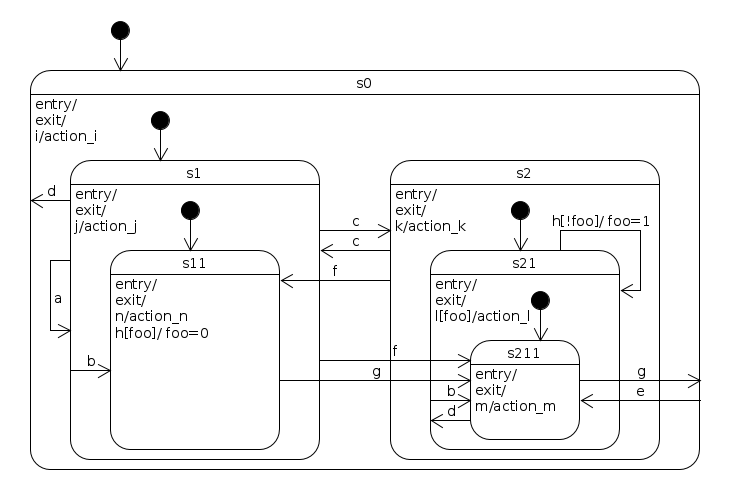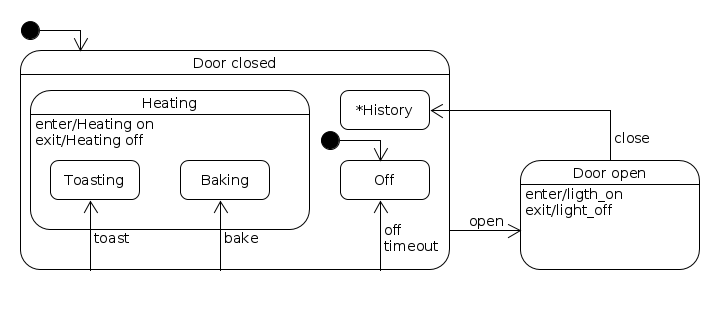Examples¶
Simple state machine¶
This is a simple state machine with only two states - on and off.
from pysm import State, StateMachine, Event
on = State('on')
off = State('off')
sm = StateMachine('sm')
sm.add_state(on, initial=True)
sm.add_state(off)
sm.add_transition(on, off, events=['off'])
sm.add_transition(off, on, events=['on'])
sm.initialize()
def test():
assert sm.state == on
sm.dispatch(Event('off'))
assert sm.state == off
sm.dispatch(Event('on'))
assert sm.state == on
if __name__ == '__main__':
test()
Complex hierarchical state machine¶
A Hierarchical state machine similar to the one from Miro Samek’s book [1], page 95. It is a state machine that contains all possible state transition topologies up to four levels of state nesting [2]

from pysm import State, StateMachine, Event
foo = True
def on_enter(state, event):
print('enter state {0}'.format(state.name))
def on_exit(state, event):
print('exit state {0}'.format(state.name))
def set_foo(state, event):
global foo
print('set foo')
foo = True
def unset_foo(state, event):
global foo
print('unset foo')
foo = False
def action_i(state, event):
print('action_i')
def action_j(state, event):
print('action_j')
def action_k(state, event):
print('action_k')
def action_l(state, event):
print('action_l')
def action_m(state, event):
print('action_m')
def action_n(state, event):
print('action_n')
def is_foo(state, event):
return foo is True
def is_not_foo(state, event):
return foo is False
m = StateMachine('m')
s0 = StateMachine('s0')
s1 = StateMachine('s1')
s2 = StateMachine('s2')
s11 = State('s11')
s21 = StateMachine('s21')
s211 = State('s211')
m.add_state(s0, initial=True)
s0.add_state(s1, initial=True)
s0.add_state(s2)
s1.add_state(s11, initial=True)
s2.add_state(s21, initial=True)
s21.add_state(s211, initial=True)
# Internal transitions
m.add_transition(s0, None, events='i', action=action_i)
s0.add_transition(s1, None, events='j', action=action_j)
s0.add_transition(s2, None, events='k', action=action_k)
s1.add_transition(s11, None, events='h', condition=is_foo, action=unset_foo)
s1.add_transition(s11, None, events='n', action=action_n)
s21.add_transition(s211, None, events='m', action=action_m)
s2.add_transition(s21, None, events='l', condition=is_foo, action=action_l)
# External transition
m.add_transition(s0, s211, events='e')
s0.add_transition(s1, s0, events='d')
s0.add_transition(s1, s11, events='b')
s0.add_transition(s1, s1, events='a')
s0.add_transition(s1, s211, events='f')
s0.add_transition(s1, s2, events='c')
s0.add_transition(s2, s11, events='f')
s0.add_transition(s2, s1, events='c')
s1.add_transition(s11, s211, events='g')
s21.add_transition(s211, s0, events='g')
s21.add_transition(s211, s21, events='d')
s2.add_transition(s21, s211, events='b')
s2.add_transition(s21, s21, events='h', condition=is_not_foo, action=set_foo)
# Attach enter/exit handlers
states = [m, s0, s1, s11, s2, s21, s211]
for state in states:
state.handlers = {'enter': on_enter, 'exit': on_exit}
m.initialize()
def test():
assert m.leaf_state == s11
m.dispatch(Event('a'))
assert m.leaf_state == s11
# This transition toggles state between s11 and s211
m.dispatch(Event('c'))
assert m.leaf_state == s211
m.dispatch(Event('b'))
assert m.leaf_state == s211
m.dispatch(Event('i'))
assert m.leaf_state == s211
m.dispatch(Event('c'))
assert m.leaf_state == s11
assert foo is True
m.dispatch(Event('h'))
assert foo is False
assert m.leaf_state == s11
# Do nothing if foo is False
m.dispatch(Event('h'))
assert m.leaf_state == s11
# This transition toggles state between s11 and s211
m.dispatch(Event('c'))
assert m.leaf_state == s211
assert foo is False
m.dispatch(Event('h'))
assert foo is True
assert m.leaf_state == s211
m.dispatch(Event('h'))
assert m.leaf_state == s211
if __name__ == '__main__':
test()
Different ways to attach event handlers¶
A state machine and states may be created in many ways. The code below mixes
many styles to demonstrate it (In production code you’d rather keep your code
style consistent). One way is to subclass the State class and attach event
handlers to it. This resembles the State Pattern way of writing a state
machine. But handlers may live anywhere, really, and you can attach them
however you want. You’re free to chose your own style of writing state machines
with pysm.
Also in this example a transition to a historical state is used.

import threading
import time
from pysm import StateMachine, State, Event
# It's possible to encapsulate all state related behaviour in a state class.
class HeatingState(StateMachine):
def on_enter(self, state, event):
oven = event.cargo['source_event'].cargo['oven']
if not oven.timer.is_alive():
oven.start_timer()
print('Heating on')
def on_exit(self, state, event):
print('Heating off')
def register_handlers(self):
self.handlers = {
'enter': self.on_enter,
'exit': self.on_exit,
}
class Oven(object):
TIMEOUT = 0.1
def __init__(self):
self.sm = self._get_state_machine()
self.timer = threading.Timer(Oven.TIMEOUT, self.on_timeout)
def _get_state_machine(self):
oven = StateMachine('Oven')
door_closed = StateMachine('Door closed')
door_open = State('Door open')
heating = HeatingState('Heating')
toasting = State('Toasting')
baking = State('Baking')
off = State('Off')
oven.add_state(door_closed, initial=True)
oven.add_state(door_open)
door_closed.add_state(off, initial=True)
door_closed.add_state(heating)
heating.add_state(baking, initial=True)
heating.add_state(toasting)
oven.add_transition(door_closed, toasting, events=['toast'])
oven.add_transition(door_closed, baking, events=['bake'])
oven.add_transition(door_closed, off, events=['off', 'timeout'])
oven.add_transition(door_closed, door_open, events=['open'])
# This time, a state behaviour is handled by Oven's methods.
door_open.handlers = {
'enter': self.on_open_enter,
'exit': self.on_open_exit,
'close': self.on_door_close
}
oven.initialize()
return oven
@property
def state(self):
return self.sm.leaf_state.name
def light_on(self):
print('Light on')
def light_off(self):
print('Light off')
def start_timer(self):
self.timer.start()
def bake(self):
self.sm.dispatch(Event('bake', oven=self))
def toast(self):
self.sm.dispatch(Event('toast', oven=self))
def open_door(self):
self.sm.dispatch(Event('open', oven=self))
def close_door(self):
self.sm.dispatch(Event('close', oven=self))
def on_timeout(self):
print('Timeout...')
self.sm.dispatch(Event('timeout', oven=self))
self.timer = threading.Timer(Oven.TIMEOUT, self.on_timeout)
def on_open_enter(self, state, event):
print('Opening door')
self.light_on()
def on_open_exit(self, state, event):
print('Closing door')
self.light_off()
def on_door_close(self, state, event):
# Transition to a history state
self.sm.set_previous_leaf_state(event)
def test_oven():
oven = Oven()
print(oven.state)
assert oven.state == 'Off'
oven.bake()
print(oven.state)
assert oven.state == 'Baking'
oven.open_door()
print(oven.state)
assert oven.state == 'Door open'
oven.close_door()
print(oven.state)
assert oven.state == 'Baking'
time.sleep(0.2)
print(oven.state)
assert oven.state == 'Off'
if __name__ == '__main__':
test_oven()
Reverse Polish notation calculator¶
A state machine is used in the Reverse Polish notation (RPN) calculator as a
parser. A single event name (parse) is used along with specific inputs (See
pysm.pysm.StateMachine.add_transition()).
This example also demonstrates how to use the stack of a state machine, so it behaves as a Pushdown Automaton (PDA)
import string as py_string
from pysm import StateMachine, Event, State
class Calculator(object):
def __init__(self):
self.sm = self.get_state_machine()
self.result = None
def get_state_machine(self):
sm = StateMachine('sm')
initial = State('Initial')
number = State('BuildingNumber')
sm.add_state(initial, initial=True)
sm.add_state(number)
sm.add_transition(initial, number,
events=['parse'], input=py_string.digits,
action=self.start_building_number)
sm.add_transition(number, None,
events=['parse'], input=py_string.digits,
action=self.build_number)
sm.add_transition(number, initial,
events=['parse'], input=py_string.whitespace)
sm.add_transition(initial, None,
events=['parse'], input='+-*/',
action=self.do_operation)
sm.add_transition(initial, None,
events=['parse'], input='=',
action=self.do_equal)
sm.initialize()
return sm
def parse(self, string):
for char in string:
self.sm.dispatch(Event('parse', input=char))
def calculate(self, string):
self.parse(string)
return self.result
def start_building_number(self, state, event):
digit = event.input
self.sm.stack.push(int(digit))
return True
def build_number(self, state, event):
digit = event.input
number = str(self.sm.stack.pop())
number += digit
self.sm.stack.push(int(number))
return True
def do_operation(self, state, event):
operation = event.input
y = self.sm.stack.pop()
x = self.sm.stack.pop()
# eval is evil
result = eval('float({0}) {1} float({2})'.format(x, operation, y))
self.sm.stack.push(result)
return True
def do_equal(self, state, event):
operation = event.input
number = self.sm.stack.pop()
self.result = number
return True
def test_calc_callbacks():
calc = Calculator()
assert calc.calculate(' 167 3 2 2 * * * 1 - =') == 2003
assert calc.calculate(' 167 3 2 2 * * * 1 - 2 / =') == 1001.5
assert calc.calculate(' 3 5 6 + * =') == 33
assert calc.calculate(' 3 4 + =') == 7
assert calc.calculate('2 4 / 5 6 - * =') == -0.5
if __name__ == '__main__':
test_calc_callbacks()
Footnotes
| [1] | Miro Samek, Practical Statecharts in C/C++, CMP Books 2002. |
| [2] | http://www.embedded.com/print/4008251 (visited on 07.06.2016) |